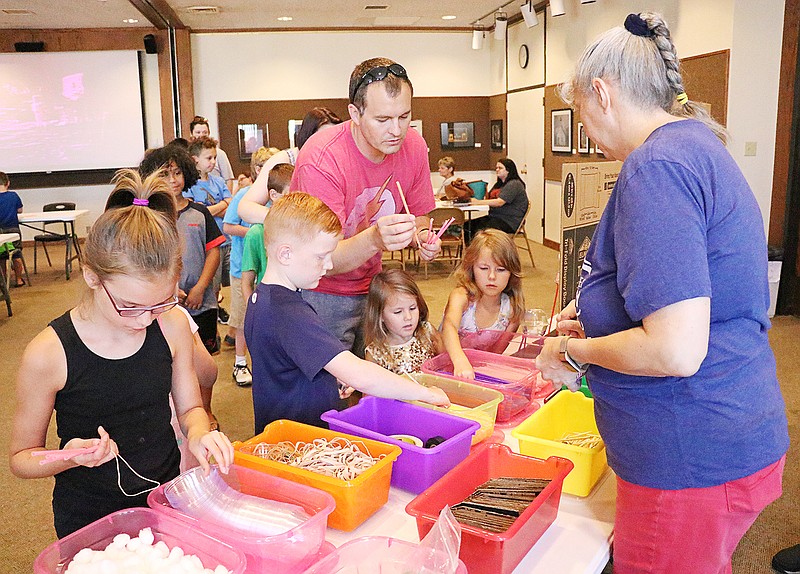On the 50th anniversary of Neil Armstrong's and Buzz Aldrin's historic walk on the moon, nearly a dozen young people and an equal number of adults gathered Saturday afternoon in the Missouri River Regional Library to learn about space flight.
The children, and many of their parents, either were too young or not alive yet on that historic day.
However, Eric Lyon, the library's Children's Programming supervisor, said event was intended "to build excitement - showing excitement for the past helps build excitement for the future. Where we are going now is Mars, and the moon is the first step (to) Mars."
Lyon said those space travel plans are "absolutely something (the kids) can get excited about. When the first person steps out on the surface of Mars, it's going to be absolutely as big to them as that first step out on the moon" 50 years ago.
Joy Johnson, of Jefferson City, served as the event's resource master, helping the children build a mock lunar rover and a mock spaceship, using cardboard, straws and cotton balls.
Johnson is a middle school science teacher at the South Callaway R-2 School District and a NASA solar system ambassador who shares the space agency's latest science and discoveries with communities.
"I just believe the kids need to know the history of space exploration," she explained, "and definitely Apollo 11 was the basis for the success."
She acknowledged learning about space will help students get ready for the plans to go back to the moon and then to Mars.
"Basically, if they know the history and what's out there," Johnson said, "it's going to help kids understand the universe and how it came to be."
She said the exercises Saturday were a way for the children to understand the basics of engineering design and "for kids to know the process that NASA goes through, designing the different land rovers and moon landers."
"For us, the library is a very good resource to learn," said Rula Nassar, who brought her children to the event. "Since it's the 50th anniversary of the Apollo mission, I wanted them to learn something new that they don't know."
She's not concerned her children won't understand the significance of the first moon walk's 50th anniversary.
"Not at all," she explained. "Even if it has a little effect now, it's going to be something that will stay with them when they're older.
"They did so much today; it's a great resource for them."
Her daughter, Salma Nassar, 9, said she enjoyed the program and learning about space, "and we get to do something new during the summer."
She thought Saturday's program helped make the 1969 moon landing "real."
Her younger brother, Edward Nassar, 8, said the program was good.
"You can learn a lot of good things about the moon, and you can learn about the first person (who stepped) on the moon, Neil Armstrong," he said.
He hopes he'll remember Saturday's exercise of building the two mock spacecraft.
"It's really important to remember because it was the first moon landing," he said.
Claire Eubanks brought her two young children to the program.
"It was a nice activity for the kids to do," she said. "My son is very excited about Apollo 11, so it was fun to read books before we came and have a nice presentation."
She hopes her children, Monte and Edna, "remember to be excited about science, engineering, to dream about going to space and maybe have some special memories of just family time together."
Historian Bob Priddy said last week, in a separate interview: "You and I walk around with more computer power in our pockets, with our cellphones, than they had, by far, to fly to the moon and to land on the moon."
That's one of the things Lyon hopes today's children learn.
"It's incredible, isn't it?" he said. "It's amazing to think that, not only the technology, but everything that was between them and the vastness of space.
"The walls of those capsules (were) essentially like a tin foil-type of thing - it was just a small wall between them and certain death.
"And we went anyway!"

